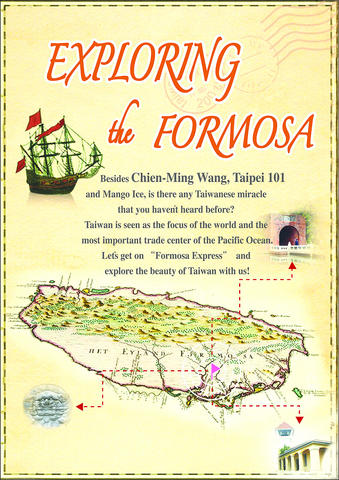To spark interest in the National Museum of Taiwan History's (國立臺灣歷史博物館) grand opening in Tainan next year, the museum's planning committee has prepared a variety of activities. Among these is Exploring the Formosa, a series of historical tours around Tainan City with an English-speaking guide. Such tours have become more common among communities around the island as people begin to take a more active interest in their immediate surroundings, but most excursions are generally targeted at Chinese-speaking people.
The full-day tour will include visits to the Anping Oyster Shell Cement Kiln Museum (安平蚵灰窯), the Old Tait & Co Merchant House (德記洋行), Anping Fort (安平古堡), Ssutsao Artillery Fort (四草砲台), Lin Mo-niang Park (林默娘公園), the Eternal Golden Castle (億載金城) and an ecological boat trip. For a registration fee of NT$500, which includes lunch and all admission tickets, this is a convenient and affordable way of getting the most out of a visit to Tainan, a city in which history is an integral part of the local identity.
This guided tour will start from the Tainan railway station, and there will be many activities to help participants understand the origins of Formosa in an interesting way.

PHOTO: COURTESY OF BRING SEVEN IN ONE CO
The idea for the National Museum of Taiwan History dates back to 1992. Former president Lee Teng-hui (李登輝), feeling the lack of a showcase for Taiwan's historical development, suggested the museum as a companion to the National Taiwan Museum (國立台灣博物館) in Taipei, the focus of which is natural history.
The massive, and trouble-prone project finally broke ground in 2003. The museum is currently under the direction of respected historian Wu Mi-chi (吳密察). Although the museum is still under construction, its ambitious digital e-museum project is up and running, in Chinese only, at www.thm.gov.tw/Emuseum.html. This offers a small taste of what the museum itself will offer.
Until the museum opens, you can sample a bit of Tainan's history through the tour. Registration ends this Friday. The first tour will take place Oct. 13, the second Oct. 20. Both are scheduled to start at 9:30am and end at 6pm. For full registration information in English, visit the event Web site at www.nmth.gov.tw/ef.

Most heroes are remembered for the battles they fought. Taiwan’s Black Bat Squadron is remembered for flying into Chinese airspace 838 times between 1953 and 1967, and for the 148 men whose sacrifice bought the intelligence that kept Taiwan secure. Two-thirds of the squadron died carrying out missions most people wouldn’t learn about for another 40 years. The squadron lost 15 aircraft and 148 crew members over those 14 years, making it the deadliest unit in Taiwan’s military history by casualty rate. They flew at night, often at low altitudes, straight into some of the most heavily defended airspace in Asia.

Many people in Taiwan first learned about universal basic income (UBI) — the idea that the government should provide regular, no-strings-attached payments to each citizen — in 2019. While seeking the Democratic nomination for the 2020 US presidential election, Andrew Yang, a politician of Taiwanese descent, said that, if elected, he’d institute a UBI of US$1,000 per month to “get the economic boot off of people’s throats, allowing them to lift their heads up, breathe, and get excited for the future.” His campaign petered out, but the concept of UBI hasn’t gone away. Throughout the industrialized world, there are fears that

Like much in the world today, theater has experienced major disruptions over the six years since COVID-19. The pandemic, the war in Ukraine and social media have created a new normal of geopolitical and information uncertainty, and the performing arts are not immune to these effects. “Ten years ago people wanted to come to the theater to engage with important issues, but now the Internet allows them to engage with those issues powerfully and immediately,” said Faith Tan, programming director of the Esplanade in Singapore, speaking last week in Japan. “One reaction to unpredictability has been a renewed emphasis on

Taiwan’s democracy is at risk. Be very alarmed. This is not a drill. The current constitutional crisis progressed slowly, then suddenly. Political tensions, partisan hostility and emotions are all running high right when cool heads and calm negotiation are most needed. Oxford defines brinkmanship as: “The art or practice of pursuing a dangerous policy to the limits of safety before stopping, especially in politics.” It says the term comes from a quote from a 1956 Cold War interview with then-American Secretary of State John Foster Dulles, when he said: ‘The ability to get to the verge without getting into the war is